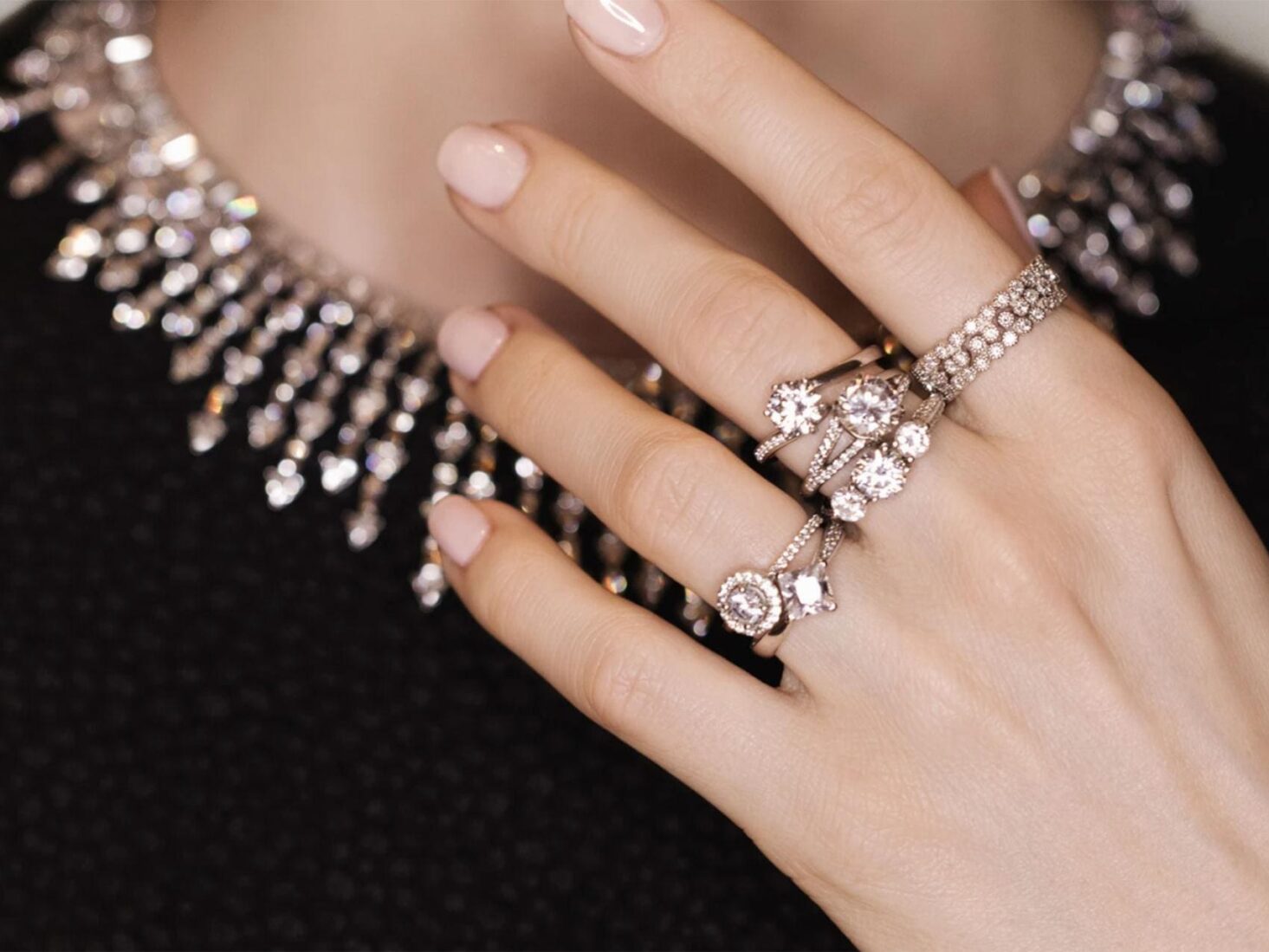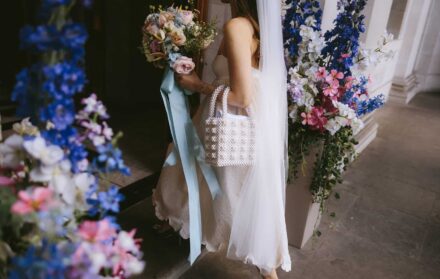
What are lab-grown diamonds – and should you be swapping to them?
Beloved by celebrities and touted as the more ethical alternative, we get the lowdown on lab-grown diamonds
In January 2019, Meghan Markle attended an event in London wearing a tastefully understated pair of earrings featuring three diamond eyes hanging from an ear-climbing wave of pavé diamonds. So far, so standard for a duchess on official duties. Except, eagle-eyed jewellery fanatics realised, those earrings were by Dutch brand Kimai and those diamonds? They’d been grown in a lab.
It is thanks to fans like Markle, along with a celebrity cohort that includes Emma Watson, Lady Gaga and Penélope Cruz, that lab-grown diamonds have taken a firm footing in the fine jewellery industry over the last decade. In fact, so convinced is he that they are the future of the market, Leonardo DiCaprio founded his own company, Diamond Foundry Inc., that grows diamonds using solar energy in 2015. So what are they, how are they different and, most importantly, where can you buy them?
What is a lab-grown diamond?
In layman’s terms, lab-grown (or cultured) diamonds are diamonds. Plain and simple. They are chemically, optically and physically identical to those occurring naturally and even the world’s most masterful gemologist could not tell the two apart.
“A cultured diamond is created in uncut form, the same as finding a diamond underground,” explains Laura Chavez, founder of Lark & Berry, the British jewellery brand that uses only cultured stones. “They also grow in different colours, clarity and sizes. So, once we have our raw cultured diamond, we can cut it to the desired shape, polish it and send it to the Gemological Institute of America or International Gemological Institute for a certificate, just like we would any mined diamond.”
For jewellery brands, there is very little difference in terms of quality or design when working with lab-grown and natural diamonds and, for the consumer, the end result is identical. It is not like comparing a natural diamond to a crystal or cubic zirconia. Cultured diamonds are the real deal: they are just as durable as mined diamonds and come with the same grading and certification.
 |  |
Are lab-grown diamonds more ethical and sustainable?
It depends who you ask but the resounding answer from most experts is, yes, absolutely. There is no such thing as a cultured ‘blood diamond’ simply because there are very few people involved in the making of a lab-grown diamond. While the modern industry is much more regulated, the history of natural diamonds is a violent and dark one, having often relied on the exploitation of poor communities in war-torn countries.
This simply isn’t an issue for diamonds grown in labs by scientists. “Mined diamonds can come certified safe by way of the Kimberley Process, but this certification has received a lot of criticism from major human rights groups as there’s still conflict that goes on that this process misses,” explains Chavez. “Not having to worry about this at all by using cultured diamonds is a huge relief, one that is priceless.”
Like any form of industrial mining, diamond mining can also have a huge environmental cost. “When it comes to procuring diamonds, there is an impact at each step, but mining is the most controversial,” says Matilde Faria Mourinho Felix, daughter of José and founder of an eponymous jewellery brand that uses only cultured diamonds. “The exploratory stage has the least impact on the environment and can benefit communities through employment opportunities, but the extraction of those diamonds is what causes such a detrimental and devastating impact on the environment.” Wildlife displacement, polluted groundwater and scarred landscapes are common side effects of mining that are eliminated by cultured diamonds.
It is worth noting, however, that there is some debate about the eco-friendliness of cultured diamonds when it comes to carbon emissions. Conflicted reports state that the carbon emissions of a cultured diamond are anywhere between a few grams and 510kg per carat. However, while more independent research is needed, with increasing numbers of lab-grown diamonds producers, such as DiCaprio’s Diamond Foundry, moving towards 100 per cent renewable energy sources, it’s safe to say lab-grown diamonds are the better environmental bet.
In fact, it is these eco credential that are turning increasing numbers of consumers and designers towards lab-grown diamonds. A 2018 survey by MVI found 70 per cent of millennials had considered buying cultured diamond engagement rings, a finding which rings true for Mourinho: “When I first learned about lab-grown diamonds it was almost a no-brainer because for me it was really important to have as little negative impacts as possible whilst bringing my jewellery to life.”
 |  |
Why are lab-grown diamonds less expensive than mined diamonds?
Now don’t start getting any ideas about building a collection to rival Elizabeth Taylor. Cultured diamonds are still diamonds so they don’t come cheap. Just as with natural diamonds, prices very according to colour, cut and clarity but, on average, cultured diamonds ring in at around $800-1,000 per carat while a natural diamond of the same cut and clarity may set you back $4,000-5,000.
The price difference becomes smaller the larger the diamond, as growing gem-quality diamonds of significant size in a lab requires a lot of research and technology, but for those of us not harbouring Mariah Carey-sized jewellery ambitions, it’s a significant price reduction. This is largely due to the removal of costs incurred during the mining process and the mark up often added to diamonds in an industry where just a handful of companies own the lion’s share of the market.

So, are lab-grown diamonds the future of fine jewellery?
If current trends are anything to go by the answer is a resounding yes. Many traditional natural diamond jewellers have long tried to create a distinction between ‘real’ and lab-grown diamonds, suggesting the latter are suitable only for demi-fine, everyday jewellery – but consumer demand doesn’t appear to be following suit.
Lark & Berry’s engagement ring sales are up 1,000 per cent, says Chavez, welcoming it as a sign that customers are more than happy to invest in cultured diamonds for big occasions. “The response from customers has been nothing short of amazing,” she says. “To us, cultured diamonds have always been the easiest ‘sell’. How could you not want to support diamond jewellery that was created with such incomparably better care for the planet and its people and for jewellery that’s going to cost you less? A more sustainable option that is less expensive? This is unheard of, except when it comes to diamonds.”
This sentiment is echoed by Mourinho, who explains, “We don’t brain wash or preach to anyone about their own values or practices, we simply offer them a chance to purchase beautiful, ethical jewellery. There will always be those who do not see lab-grown diamonds as ‘real’ diamonds but hopefully over time their interest will grow.
“I would like to see [the industry] change in a more positive, kinder, and sustainable direction. I think based on the changes in consumer behaviour we have increasingly seen over the last few years, a jewellery brand that uses lab-grown diamonds won’t be something super unique and rarely done, but the norm for the industry.”
 Deusa ring in 14k recycled yellow gold, £450, matildejewellery.com |  Mini Leaf necklace in 18k recycled rose gold, £695, kimai.com |  Flora 18k white gold diamond earrings, £4,950, larkandberry.com |
Many detractors of lab-grown diamonds point to their disappointing track record when it comes to resale value as a sign of inferiority. However, while it’s true that you’re unlikely to be able to sell a piece of cultured diamond jewellery for anything near the original asking price, both women are keen to point out that this has always been the case with natural diamonds, the majority of which fetch as little as 20 per cent of their new price on the resale market.
“Many think their mined diamonds will keep their value but it’s tricky to say unless it’s a rare find, high-valued item,” explains Mourinho. “I believe in the value of heirlooms handed down from generation to generation and hold just as much value for sentimental reasons.”
“Cultured diamonds are created for use in jewellery – they’re not meant to be locked in a museum showcase or in a safe,” adds Chavez. “When people buy any diamond, I tell them they should buy it because of what it represents to them. No matter whether their diamond is mined or grown it will still last them forever, and it can still be passed on to loved ones.”
Read more: The best ethical and sustainable British jewellery brands









